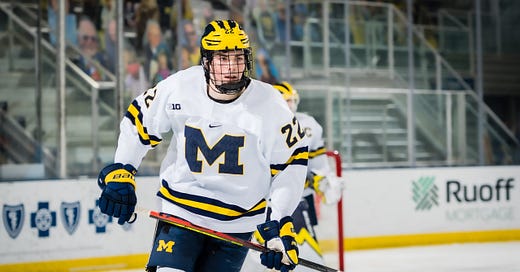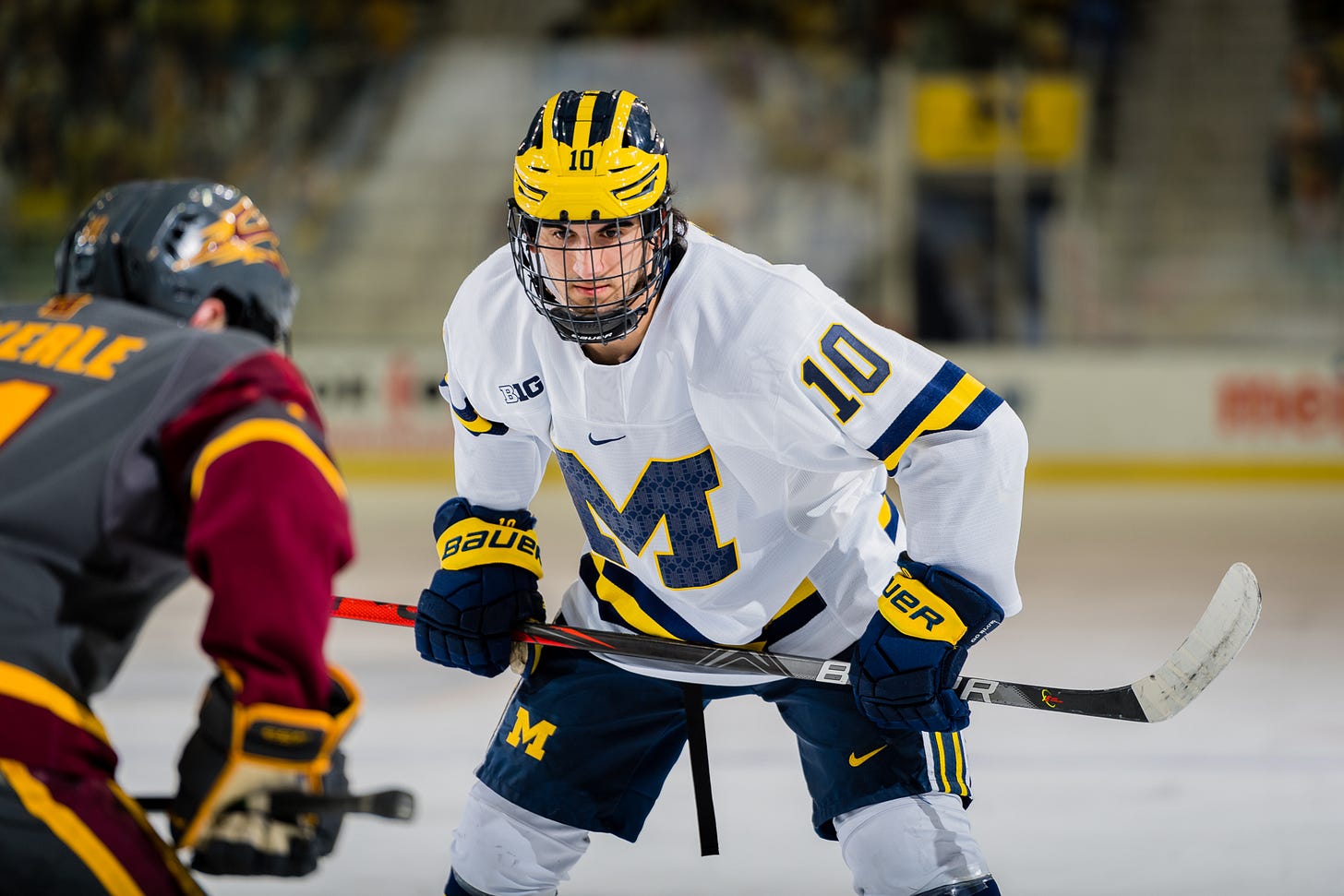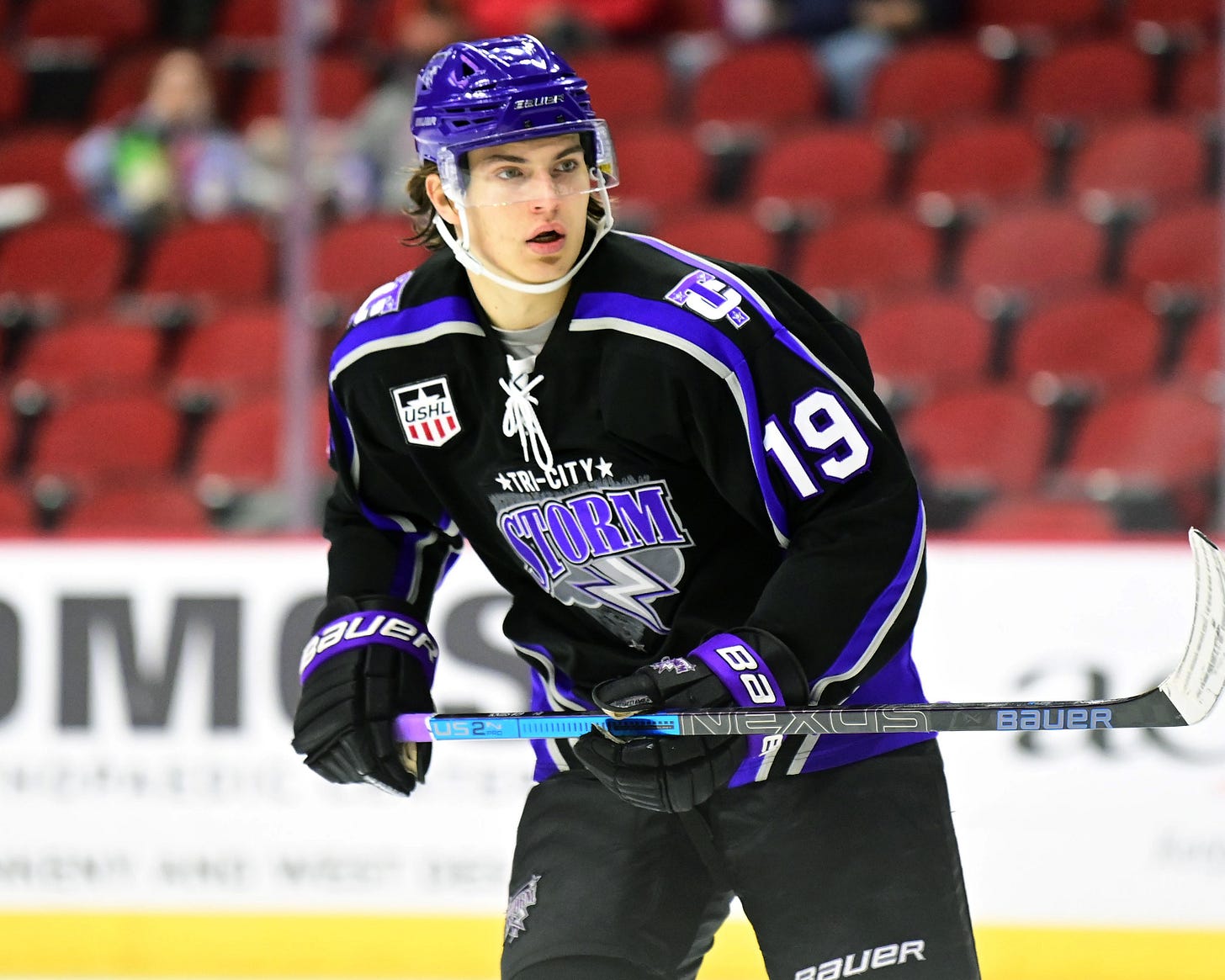Free Preview: 2021 NHL Draft Rankings
Check out the top three players on Chris's list from his rankings released Friday
If you’re receiving this email, you’re on the Hockey Sense free email list. Thanks for checking out the site and signing up! If you didn’t see this week, I released my final draft rankings for 2021.
I wanted to give all of my free signups a sneak peek at the top three prospects, plus a few capsules on prospects from further down the board to give you a taste of what you can expect from the site. If you like what you see, consider upgrading for premium content access.
To get access to the full draft rankings and all of the other premium pieces on the site, all it takes is $6 for a monthly subscription. By subscribing today, you’ll be covered all the way through the draft, getting access to forthcoming content including players who just missed my top 90, late-round prospects to know and a few more mock drafts coming your way. On top of that, I’ll have instant draft analysis the night of the first-round and more recap content in the days following NHL Draft weekend.
The summer will be full of additional content like farm system rankings, NHL-affiliated prospect rankings, 2022 NHL Draft year previews, U.S. World Junior Camp coverage and more. Don’t forget you can save three months off of the monthly fee by purchasing an annual subscription.
Click here for access to the full list.
Thanks again for your interest in this new independent venture. I appreciate your support!
2021 NHL Draft Final Rankings — TOP THREE
1. Owen Power, D, Michigan (Big Ten)
After a full season of watching Power at Michigan, it was an added bonus to see him at the Men’s World Championship. Especially since he climbed up the depth chart the entire tournament and became one of the team’s most important players down the stretch, eventually playing a key role as Canada won the gold medal.
The first big plus is his combination of size and skating ability. Power does not look like an explosive skater, but he’s powerful and his long strides are so useful in recovery or taking pucks up ice. His range, reach and ability to close gaps all comes from a good base of skating. Then he’s got the smarts. Power is a cerebral player who anticipates instead of reacts. When you’re 6-foot-5 and have the reach that he does, there could be an over-reliance on it, but that’s not the case for Power. He likes to defend in tight and keep everything in front of him. Power has good battle ability along the walls, using his size and strength to win pucks or keep plays to the outside. An especially quick forward can still cross him up from time to time, but largely he’s not going to get beat clean too often. It’s something that took time for him to build up as earlier in the season, I had some concerns about his defensive footwork, but not by the end.
Offensively, Power is solid, if unspectacular. He has a good, strong shot from the point, extends plays on the offensive blue line and has good offensive zone awareness. He makes mostly good reads on his best options, with excellent passing and ability to get pucks through and to the net. Power can also get engaged on the rush, with confident abilities in carrying pucks through the neutral zone. He also picks his spots well with when and how to jump into plays and provide offensive support. There’s not much flash to his offense, but it’s effective.
As mentioned in the previous report, Power has been on a steady progression over his last three seasons, starting as an exceptional 16-year-old in the USHL, then the best defenseman in the league at 17 and a high-end defenseman in college as a true freshman. He’s taken a step every year. After watching him in the World Championship, his game is still progressing at a similar rate, and I think it’s fairly safe to say he’s the most NHL-ready prospect in this draft.
I’ve said it before, though, and I will say it again – This may be the best year to try and give players some extra time at their respective leagues. Let Power go back to college and dominate and arrive as a more finished product. He has a chance to be a special, long-term piece of an NHL blue line so making all of the right moves in his development is going to be key.
2. Matty Beniers, C, Michigan (Big Ten)
Matty Beniers is simply a player you win with. His on-ice drive is unmatched in this draft class as he’ll compete every single shift and make thing hectic for the opposition whether he has the puck or he doesn’t. There’s never really any time where he drops his intensity level, which makes him one of the best puck pursuers in this class. It also makes him a defensively responsible, challenging player to play against. Teams are at a disadvantage when he’s on the ice, because there’s another precocious defender out there.
When it comes to offense, Beniers does not have overtly dynamic puck skills, but his footwork and ability to create separation are two things that take his offensive game to the next level. He drives the middle lane, makes plays off the wall and has the ability to take pucks hard to the net or find the right passing lane for a better play. His awareness and processing speed in the offensive zone are high-end traits of his elite-level hockey sense.
The team that drafts Beniers has no worse than a No. 2 center on their roster who can handle tough matchups, play on their power play, their penalty kill and probably one day wear a letter for their team. There are more dynamic offensive players in this draft, but there isn’t a single forward who impacts the game in as many ways as Beniers does.
3. William Eklund, LW, Djugårdens (SHL)
The maturity and poise it takes to be a top-line player as an 18-year-old professional is rare. It’s why so many don’t get the chance. Eklund earned it, however, and rewarded his club with solid performance after solid performance. In a class that lacks a ton of dynamic talent, Eklund has it. He’s quick, smart and creative, making plays with pace and precision. Eklund finished the season with 23 points in 40 games, marking the fifth-most productive season for a draft-eligible player in SHL history. Eklund was named the league’s rookie of the year, too.
We didn’t get to see Eklund at the World Juniors or the men’s Worlds, though he was trending towards a selection to Team Sweden before being injured. His confidence over the course of the season was evident in his play. He sees the ice incredibly well and processes the game at pro speeds. To think he played 20 SHL games last season and only put up two assists seems hard to believe. He was a legit force in a very good pro league.
Eklund has been in the shadow of Lucas Raymond and Alexander Holtz, two players in the same birth year but a year ahead in draft status. I think Eklund is close to those two in terms of his overall upside. In fact, he might be a bit ahead of Holtz whom he played with this season at Djugårdens. I think Eklund will need a year or two more in Sweden before he can come over, especially as he needs to continue to build strength and refine the defensive elements of his game. But whichever team drafts him is going to feel they’ve got a future top-six scorer with their club with high hopes for what he can deliver offensively.
2021 NHL Draft Rankings — Sample Capsules
40. Matthew Knies, LW, Tri-City Storm (USHL)
It took him a while to get rolling this season, but once he did, he was tough to stop. Knies had four points in his first 13 games before going on a bit of a tear with 38 points in his next 31 games, which included an end-of-season run of points in 13 of his last 14 games. Knies is a big forward with an ability to get to the net and make plays in tight. He has a good shot, but also is a solid passer, making good reads with effective distribution. His ability to create trouble at the net-front also helped his teammates pick up the garbage if he didn’t bury it himself. For a big guy, there’s some nice fluidity in Knies’s game, without losing the edge. I think he’s much closer to the player he was at the end of the season than he was the player at the beginning of the year that struggled to score. I’m looking forward to seeing how he continues to round out his game at the University of Minnesota starting next season.
56. Dylan Duke, LW, U.S. National Under-18 Team (NTDP)
One of the truly incredible net-front players in this draft, Duke does not have the prototypical size of a guy you expect to be doing damage near the net and below the goal line, but he takes it. His instincts near the net are impressive, then you combine that with a relentless competitiveness and quick hands around the net and you have a threatening player. Valid questions about Duke, however, are if there’s a lot more to his game. He’s not an especially good skater for his size and isn’t going to drive a lot of play, but he does have real offensive intelligence and know-how, which is why he scored 29 goals this season, almost all of which came from beneath the faceoff dots in the offensive zone. There are a lot of prospects that we dub natural goal scorers who score from distance, Duke does all of his damage in front and that’s a unique trait among his peers in this range.
80. Colton Dach, C, Saskatoon Blades (WHL)
The younger brother of 2019 third-overall pick Kirby Dach, Colton has the same big frame, which he uses well. Dach’s standout tool is probably his shot as he can absolutely let it fly. He scored 11 goals in 20 WHL games this season and is just as effective at the net front as he is with outside shots. The issue with Dach is his skating is not at a level that projects very favorably to NHL regular. I think the hands and his size can carry him a bit, he seems to have pretty good hockey sense if not spectacular. But the stride is heavy and that could scare teams away even in a draft where there’s not a ton of high-end skating talent.
Thanks for checking out the free preview. If you’d like to see capsules for all 91 players listed, subscribe and find the full final rankings here.






